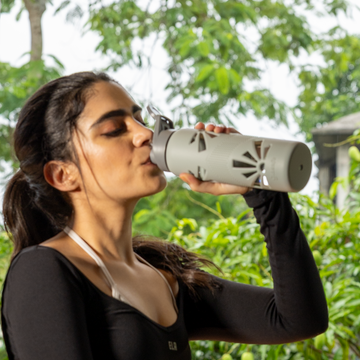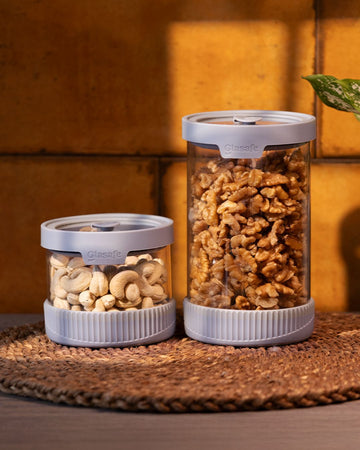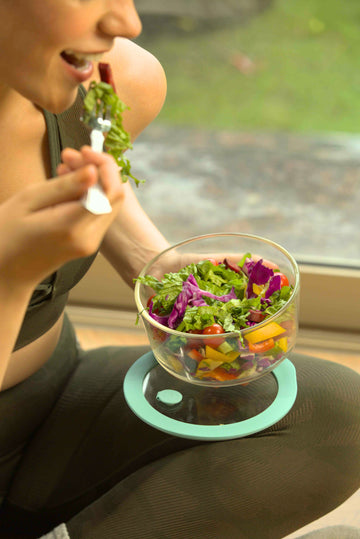Why Storing Hot Food in Plastic Containers is Harmful to Your Health?
We frequently take shortcuts without thinking twice in the hustle and bustle of daily life. It feels normal, even handy, to scoop hot sabzi from a plastic box, pack freshly cooked biryani in a plastic container, or reheat leftovers from the previous evening in a plastic container. However, this routine behavior can be subtly harming your health.
Here we will give you all the answers and perhaps even a wake-up call you need to know if your plastic food containers are indeed safe to use for storing hot meals. Let's know the dangers of storing hot food in plastic containers, their reasons for being dangerous, and ways to improve your kitchen's health.
What Science Says About Plastic and Heat
Scientific research has consistently raised red flags about using plastic containers for hot foods. According to studies:
-
BPA is an endocrine disruptor, which means it can interfere with the body’s natural hormone system. Even small doses over time may affect fertility, immunity, and brain development.
-
A 2011 Harvard study found that people who drank hot liquids from plastic bottles had significantly higher BPA levels in their urine than those who didn’t.
-
The World Health Organization (WHO) and Endocrine Society have also warned against regular exposure to these chemicals due to links to diabetes, obesity, cardiovascular disease, and hormone-related cancers.
What Happens When You Put Hot Food in Plastic?
Because plastic tends to break down at the molecular level, placing hot food in plastic containers, especially ones that aren't made for high temperatures, can cause chemicals from the plastic to seep into the food. Toxic chemicals used in the manufacturing process may be released when hot curry, soup, or dal is poured into a plastic container. Because BPA and phthalates, two chemicals included in plastics, are known endocrine disruptors, they may be harmful to one's health. These substances have the ability to disrupt hormone processes and raise the risk of a number of illnesses, such as cancer and reproductive disorders.
These harmful chemical includes, BPA (Bisphenol A), Phthalates, Styrene (found in polystyrene or foam containers), BPS (a BPA replacement that’s not much better). These chemicals are known to leach into your food, particularly when it’s acidic or oily, both of which act as solvents, accelerating the chemical leaching process.
And once they are in your food, you are not just digesting calories and nutrients, you are also consuming compounds that trigger your hormones and harm your body at a deeper level.
Are Microwave-Safe Plastics Really Safe?
The answer is simple: No! This is a common misconception: “But my tiffin says microwave-safe!”
Let’s bust this myth: The label "microwave-safe" only means the plastic won’t melt or deform in the microwave or oven. It doesn’t guarantee that no chemicals will leach into your food when heated.
And what about those worn-out containers with scratches and stains? They are even more dangerous. Heat accelerates the release of chemicals from old or cracked plastic, especially after repeated use. So, even if your container survives the microwave, your health might not.
5 Hidden Health Risks of Storing Hot Food in Plastic
Let’s look at the long-term health impact of eating food stored in plastic containers repeatedly:
-
Hormonal Imbalance: Plastics can mimic hormones, like estrogen, confusing the body’s natural balance. This is especially dangerous for pregnant women, babies, and children.
-
Reduced Fertility: Research has linked BPA and phthalates to decreased sperm quality in men and ovarian dysfunction in women.
-
Higher Risk of Cancer: Studies show prolonged exposure to plastic chemicals may increase the risk of breast cancer, prostate cancer, and other hormone-sensitive cancers.
-
Metabolic Disorders: Endocrine disruptors have been associated with weight gain, insulin resistance, and type 2 diabetes.
-
Brain and Developmental Issues in Children: Prenatal and early-life exposure to plastic toxins can affect brain development, attention span, and learning abilities in children.
What About Cold Food in Plastic?
Cold food poses a lower risk, but it’s still not risk-free, especially with acidic or greasy items like pickles or tomato chutney. Over time, even without heat, chemical migration can occur, particularly in low-quality plastics.
So yes, the best practice is to eliminate using plastic in your day-to-day life. It’s not just for hot food; plastic is the main culprit in various situations.
Safer Alternatives to Plastic for Hot/Cold Food Storage
Your kitchen deserves better. And so does your health. Here are the top substitutes for plastic containers:
1. Borosilicate Glass Containers or Tiffins: They are the best material for storing food, whether hot or cold. Borosilicate glass bowls, containers, or tiffins from Glasafe are:
-
Heat-resistant
-
Microwave-safe
-
Toxin-free
-
Odorless
-
Doesn’t stain or leach chemicals
Perfect for reheating, storing, and even serving. Glass is the gold standard. Borosilicate glass is the safest and most versatile alternative to plastic; it does it all without compromising your health. It handles temperature shifts effortlessly and even looks premium on your table.
If there’s one lifestyle upgrade your kitchen needs, it’s switching to borosilicate glass containers. Borosilicate glassware products from Glasafe are elegant, durable, and designed for real-life use.
2. Stainless Steel Containers: This material is quite durable and good for everyday use, may it be at home or on travel. However, they can be bulky and may react with acidic food items.
-
Durable
-
Non-reactive (sometimes)
-
Safe for hot, dry, or moist foods
A great option for carrying meals on the go; just don’t use them in the microwave.
3. Ceramic and Stoneware: They look classy and are great options for your kitchenware. They come in different shapes, sizes, colors, and designs. They are:
-
Ideal for reheating and storing food
-
Aesthetic and safe
Ensure it's lead-free, non-porous, and crack-free for safe use.
4. Silicone Lids or Wraps: They help store food in the refrigerator easily without having to swap between different containers.
-
A safer alternative to plastic wraps
-
Flexible and reusable
Great for covering hot bowls or containers.
Real-Life Kitchen Swaps You Can Start Today
The Eco-Health Bonus
Let’s not forget: plastic isn’t just bad for you, it’s bad for the planet too. By reducing plastic usage in your kitchen, you are contributing to a healthier ecosystem, cutting down on non-biodegradable waste, and setting an example for those around you. In short, your small switch has a big ripple effect.
Final Thoughts
We take so much care with ingredients. Organic veggies, cold-pressed oils, homemade ghee, but if that lovingly prepared food sits in a chemical-leaching container, what’s the point?
Health doesn't just come from what you eat. It also depends on how you store, heat, and serve your food. So, the next time you are about to pour that hot dal into a plastic dabba, pause and rethink.
FAQs
1. Can hot food be stored in any plastic container?
No, hot food should not be stored in plastic containers. All plastic containers, including those labeled as BPA-free, may contain BPS or other dangerous alternatives that might contaminate your food, according to studies. The risk is merely increased by heat. When eating hot food, stick with a glass container.
Q2. How can I tell if my container is safe to use in the microwave?
Keep in mind that just because something is microwave-safe, it doesn't necessarily mean it is toxin-free. If there isn't a symbol, don't microwave it, especially if it's made of Styrofoam or disposable containers. Only premium ceramic or borosilicate glass containers can really meet both requirements.
Q3. Is it safe to keep hot food in Tupperware?
Because of the possibility of chemical leaching, it can be dangerous to store hot food in Tupperware or any other plastic container. According to specialists at Harvard Medical School, heating plastic, particularly when hot food is involved, can hasten the release of chemicals like phthalates and BPA, which are known endocrine disruptors.
Q4. Are plastic containers that are reused safer than those that are thrown away?
Reusable plastic containers are not always safer than single-use ones;, if they are not properly maintained, they may even present more risks. Although reusable containers are frequently praised for their positive environmental effects, their safety varies depending on the kind of plastic, how often they are used, and how they are cleaned. Contrarily, disposable containers are made to be used only once and typically don't have the possibility for hazardous chemicals to leak or microplastics to shed, which can happen when reusable containers are used repeatedly.
Q5. What if I'm not ready to give up plastic entirely?
Take small measures at first. Use steel or glass to store hot products, and only use plastic for dry or cold foods. Switching to glasses products and making small adjustments go a long way.





